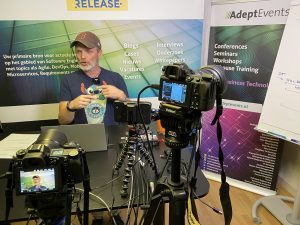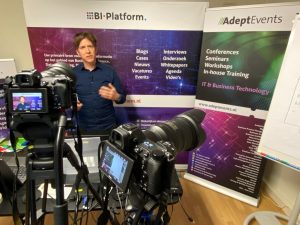Barry Devlin
9sight Consulting
Met meer dan 30 jaar ervaring in IT, waarvan 20 jaar bij IBM als "Distinguished Engineer", is hij een alom gewaardeerd consultant, docent en auteur.
[Let op: drie online ochtendsessies van 9:00 tot 13:00 uur. Dit format wordt zeer goed beoordeeld!]
The data warehouse is now middle-aged. BI has turned twenty and the data lake ten. So, is it time for something new? Something better? In fact, three new frameworks have recently emerged: data fabric, data mesh, and data lakehouse.
But what are they? Are they truly novel or simply marketing hype? In essence, all three are competing technological responses to the growing needs of digital transformation. If you are facing the urgent challenges of delivering high-value, consistent, and near real-time information across Cloud and on-premises environments, understanding these approaches and their differences is critical. Learn if you should move beyond your existing data warehouse or lake and, if so, how.
In this course, Barry Devlin explains and positions data fabric, mesh, and lakehouse, as well as other concepts, old and new, using a logical digital information systems architecture framework. Exploring existing and emerging technologies as well as organisational issues, methodologies, and implementation approaches, Barry will help you decide if one of these new approaches is right for your business needs, existing technical environment, and current skills.
The seminar
Three new data delivery and information preparation approaches have recently emerged to challenge current data warehouse and data lake thinking. Each has its pros and cons, strengths and weaknesses. Data fabric proposes active metadata and knowledge graphs to power a logical data warehouse approach. Data mesh suggests that a domain-oriented, self-service approach based on microservices thinking should be adopted, eliminating data copies almost entirely. Data lakehouse, as the name implies, attempts to combine the best of data warehouse and data lake, as well as promising transactional consistency within its scope.
All these new and old terms, with partially overlapping scopes, preferred technology bases, and different promoters, are types of digital information systems. Their aim is to prepare, deliver, and manage data / information to all decision-making and action-taking business processes.
Today’s business, with its conflicting needs for data timeliness vs. consistency, immediate vs. correct decisions, and information-informed competition, places extensive new demands on digital information systems. These demands have led to the emergence of the lakehouse, fabric, and mesh approaches honed for the complex distributed and network-centric environments that are already common. However, the prevalence of legacy systems, historical data management issues, as well as existing and evolving complications in information meaning and usage mean that traditional approaches and knowledge cannot be readily abandoned.
The key questions, therefore, are if and how data lakehouse, fabric, and mesh address these new needs, how differently each does that, where they improve on existing approaches or create new problems, and how they can coexist with or replace established data warehouses and lakes.
To answer these questions, Barry Devlin compares and contrasts all these approaches, old and new, using as a foundation the Digital Information Systems Architecture (DISA) first defined in “Business unintelligence.” Existing and emerging technologies for data storage, preparation, and virtualization; data catalogs and knowledge graphs; and other tools, both on-premises and Cloud, are described and analysed. Also explored are a wide variety of organisational issues, methodologies, and implementation approaches that are often as important in assessing solutions as the underlying technologies.
What you will learn
DISA is the new name for the conceptual and logical architectures introduced in “Business unIntelligence”
Who should attend?
De virtuele seminars en workshops worden aangeboden via een online meeting platform, in de regel Webex of Zoom, vanuit onze lokale cursusruimte annex videostudio, Studio 44. Omdat wij werken met een tweepersoons crew en meerdere professionele camera’s en microfoons, is het mogelijk om de traditionele cursusruimte waar nodig volledig na te bootsen en daarbij vooral ook de interactie met deelnemers op peil te houden.
 Optimale interactie
Optimale interactie
De spreker / trainer beschikt nog steeds over zijn Powerpoint, fysieke flipchart met papier alsmede een virtueel én fysiek whiteboard en wordt begeleid door een operator/moderator. Alles is er op gericht om de trainer te ontzorgen qua techniek zodat hij zich kan concentreren op de inhoud en de interactie met de online deelnemers.
 Bij gebruik van de “Raise Hand” functie zal de moderator de trainer attenderen op de deelnemer die een vraag wil stellen.
Bij gebruik van de “Raise Hand” functie zal de moderator de trainer attenderen op de deelnemer die een vraag wil stellen.Door dit alles wordt het geen onpersoonlijk één-richtingsverkeer webinar maar een interactieve virtuele classroom setting.
Deelnemers aan online events of aan hybride events via het online meeting platform ontvangen enkele dagen van tevoren de uitnodiging met hyperlink en benodigde instructie.
Wilt u deze sessie exclusief binnen uw eigen organisatie aanbieden voor een groep medewerkers? Een zeer aantrekkelijke optie met hoog rendement! Nu ook online of op locatie met deelnemers in de zaal plus online deelnemers.
Stappenplan en best practices Organisaties hebben behoefte aan data science, selfservice BI, embedded BI, edge analytics en klantgedreven BI. Wat komt er kijken bij het ontwerpen van een moderne data-architectuur? Dit seminar biedt richtlijnen, stappenplannen, tips, ontwerpregels, use cases en praktijkvoorbeelden.
14 en 15 mei 2025
Utrecht
Collaborative BI Requirements Analysis & Dimensional Modeling Training Training dimensioneel modelleren door datawarehouse autoriteit Lawrence Corr waarin de nieuwste technieken worden behandeld voor het vergaren van BI-requirements en het ontwerpen van effectieve datawarehouse- en BI-systemen. Een agile benadering voor dimensioneel modelleren (star schema).
19 t/m 21 mei 2025
Utrecht
Business Intelligence, Datawarehousing, Big Data en Datamanagement Website op gebied van BI, datawarehousing, big data, analytics en data science maar ook datamanagement en datamodelleren. BI-Platform is een onmisbare bron van informatie met o.a. blogs door thought leaders, nieuws, (video)interviews, whitepapers, vacatures en agendarubriek en fraaie app.
